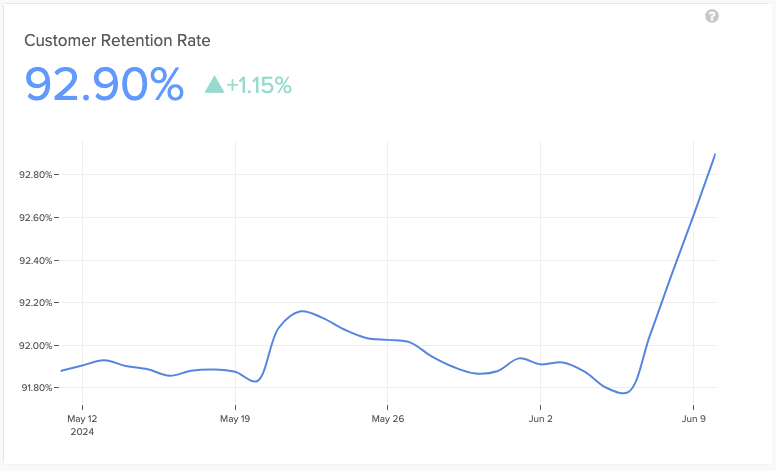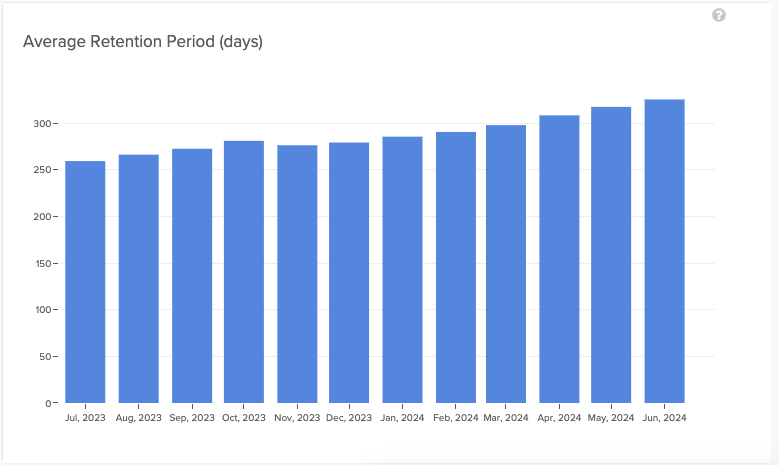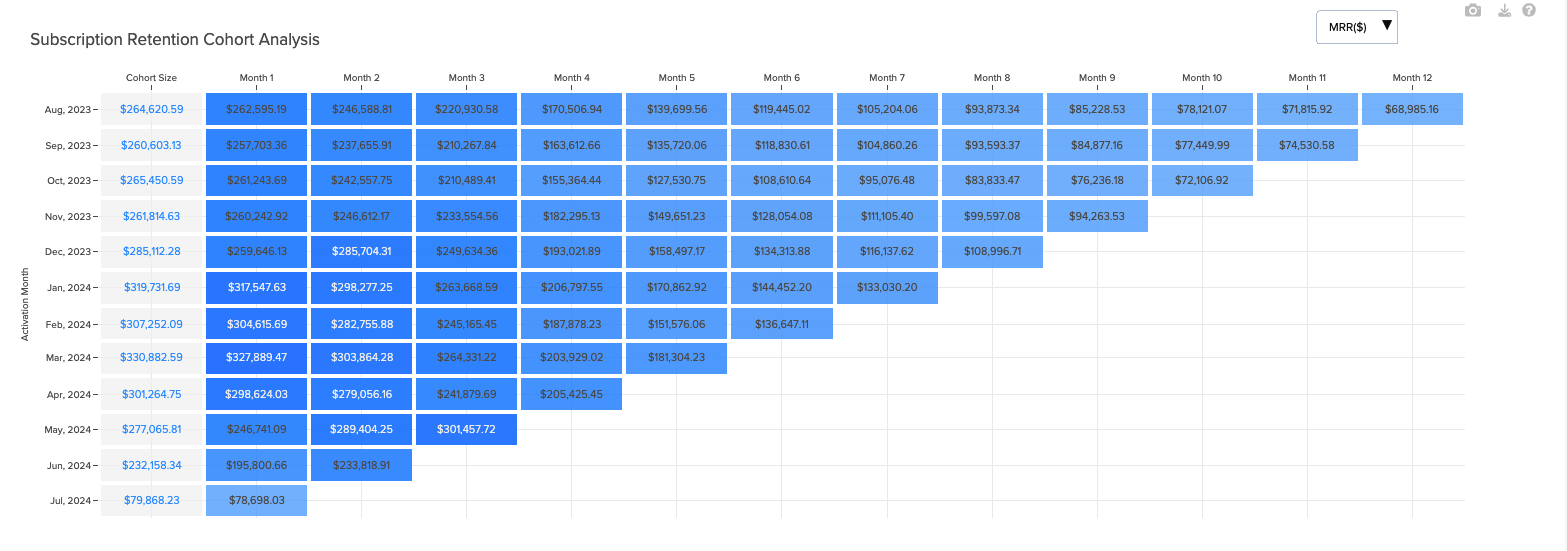Retention Dashboard
On this page, you'll find a reference to the metrics that FastSpring tracks and surfaces in your store's Retention Dashboard.
The sections that follow explain the methodology and formulas that FastSpring uses in its subscription retention and churn analysis, alongside explanations of the charts you’ll find in your dashboard.
MRR Retention Rate
MRR Retention Rate shows the percentage of Monthly Recurring Revenue (MRR) retained over the previous 30 days.
Methodology
FastSpring calculates MRR Retention Rate daily using the following formula:
MRR Retention Rate (percentage) = 100% - MRR Churn Rate
For example, if the MRR Churn Rate on a given day is 10%, then the MRR Retention Rate on the same day would be 90% (100% - 10%).
MRR Retention is directly related to MRR Churn Rate, which measures the percentage of MRR lost within a 30-day period. Since MRR Retention Rate is calculated based on the same 30-day period, it complements MRR Churn Rate, with both rates always totaling 100%.
Example
This example chart shows MRR Retention Rate and its daily fluctuations over the course of a month:

Customer Retention Rate
Customer Retention Rate shows the percentage of customers retained over the previous 30 days.
Methodology
FastSpring calculates Customer Retention Rate daily using the following formula:
Customer Retention Rate (percentage) = 100% - Customer Churn Rate
For example, if the Customer Churn Rate on a given day is 15%, then the Customer Retention Rate on the same day would be 85% (100% - 15%).
Customer Retention Rate is directly related to Customer Churn Rate, which measures the percentage of customers who canceled all their subscriptions within a 30-day period. Because Customer Retention Rate is calculated based on the same 30-day period, it complements Customer Churn Rate, with both rates always totalling 100%.
Example
This example chart shows Customer Retention Rate and its daily fluctuations over the course of a month:

Average Retention Period
Average Retention Period represents the average number of days subscriptions remain active.
Methodology
FastSpring calculates the Average Retention Period by identifying all active subscriptions as of the last day of each month, summing the total active days for these subscriptions, and dividing by the number of active subscriptions.
Example

This chart shows the Average Retention Period for the 12 months leading up to the end of the selected time range. For example, if you selected a time range from October to September (like in this example), the chart would show values for each month from October of the previous year to September of the current year.
If you apply a product filter in the chart, FastSpring will adjust the chart to show data specifically for the product you selected. For each month, the metric is calculated by looking only at subscriptions that were linked to that specific product at any point during that month. This means that if a subscription was associated with the product, even for a short time within the month, it will be included in the calculation for that month.
Subscription Retention Cohort Analysis
The Subscription Retention Cohort Analysis chart tracks how many subscriptions from a given cohort are retained over time.
Chart Structure

The chart is structured as follows:
- The vertical axis shows the months in which the cohorts started, with the current month at the bottom.
- The horizontal axis shows the number of months since the cohort started, labeled as Month 1, Month 2, and so on.
- The first column shows the number of subscriptions (cohort size) activated during each starting month.
- Each cell shows the percentage of subscriptions from the initial cohort retained in subsequent months. These percentages always refer to the initial cohort size, not the retained subscriptions from the previous month.
Keep the following in mind as you view the Subscription Retention Cohort Analysis chart:
- Retention calculation percentages are calculated based on the initial cohort size and can reflect changes due to deactivations or upgrades.
- When you apply a product filter, only subscriptions activated with that product will be considered as part of each cohort.
- Subscriptions can be deactivated in their first month, like weekly subscriptions, so Month 1 retention might not always be 100%. Monthly subscriptions are only considered churned after the next re-billing cycle.
- The color of each cell indicates its percentage value, ranging from dark blue (high retention) to light blue (low retention). This visual representation helps highlight variations in retention over time.
- The toggle lets you switch between displaying retained subscriptions as percentages or an absolute number.
- You can download the Subscription Retention Cohort Analysis data. FastSpring will generate the data either in percentages or numbers, depending on the value you have toggled on when you initiate the download.
MRR Retention Cohort Analysis
The MRR Retention Cohort Analysis chart tracks how much of the initial Monthly Recurring Revenue (MRR) from subscriptions is retained over time.
Chart Structure

The chart is structured as follows:
- The vertical axis shows the months in which the cohorts started, with the current month at the bottom.
- The horizontal axis shows the number of months since the cohort started, labeled as Month 1, Month 2, and so on.
- The first column shows the number of subscriptions (cohort size) activated during each starting month.
- Each cell shows the percentage of the initial MRR retained in the subsequent months. These percentages always refer to the initial cohort MRR, not the MRR from the previous month.
Keep the following in mind as you view the MRR Retention Cohort Analysis chart:
- Retention calculation percentages can reflect growth due to upgrades or other events, meaning MRR can increase as well as decrease.
- FastSpring will include in the cohorts only subscriptions that were activated with the selected product.
- Subscriptions can be deactivated in their first month, so Month 1 retention might not always be 100%.
- Like the Subscription Retention chart, the color of each cell indicates its percentage value, ranging from dark blue (high retention) to light blue (low retention).
- The toggle lets you switch between displaying percentages or dollar amounts.
- You can download the MRR Retention Cohort Analysis data. FastSpring will generate the data either in percentages or numbers, depending on the value you have toggled on when you initiate the download.
Voluntary and Involuntary Churn
The Voluntary and Involuntary Churn metrics track the number of subscriptions lost due to both voluntary and involuntary reasons.
Proportional Chart

Keep the following in mind as you view the proportional churn chart:
- The donut chart visualizes total churned subscriptions, divided into voluntary and involuntary churn.
- The toggle lets you switch between showing churn as the total subscription count or as MRR.
Twelve-Month Analysis

Keep the following in mind as you view this chart:
- This chart shows data for the last twelve months.
- The vertical axis shows the number of churned subscriptions or MRR (depending on which you have toggled on).
- The horizontal axis shows each of the last twelve months.
- Each bar represents the total number of churned subscriptions for each month, divided into voluntary and involuntary churn, in blue and light green, respectively.
Updated 3 months ago